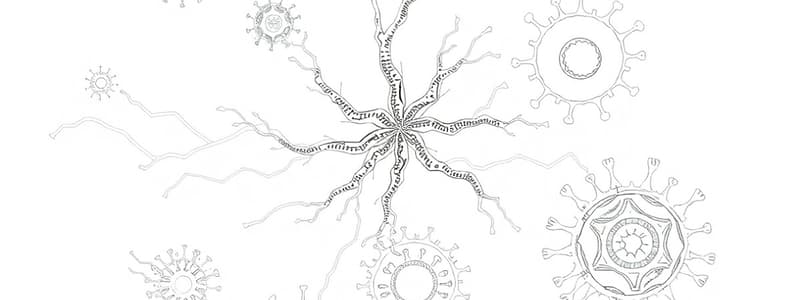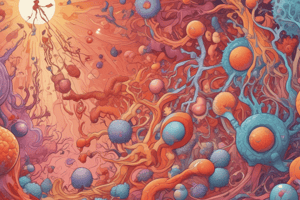Podcast
Questions and Answers
Which of the following cell types is NOT a resident immune cell, waiting in tissues before an infection or injury?
Which of the following cell types is NOT a resident immune cell, waiting in tissues before an infection or injury?
- Macrophages
- Neutrophils (correct)
- Dendritic cells
- Mast cells
Which of the following is NOT a primary function of mast cells in the inflammatory response?
Which of the following is NOT a primary function of mast cells in the inflammatory response?
- Increase capillary permeability
- Phagocytose pathogens (correct)
- Release histamine and cytokines
- Contribute to vasodilation
What is the primary mechanism by which neutrophils are recruited to the site of infection or injury?
What is the primary mechanism by which neutrophils are recruited to the site of infection or injury?
- Active transport by the lymphatic system
- Passive transport through the blood stream
- Chemotaxis in response to chemokines (correct)
- Random movement and diffusion
During the inflammatory response, what is the primary effect of the release of histamine by mast cells?
During the inflammatory response, what is the primary effect of the release of histamine by mast cells?
Which of the following best describes the role of chemokines in the inflammatory response?
Which of the following best describes the role of chemokines in the inflammatory response?
Which of the following is NOT a cardinal sign of inflammation?
Which of the following is NOT a cardinal sign of inflammation?
Which of the following statements accurately describes the relationship between innate immune cells and adaptive immune cells in the inflammatory response?
Which of the following statements accurately describes the relationship between innate immune cells and adaptive immune cells in the inflammatory response?
Which of the following accurately describes the process of extravasation during the inflammatory response?
Which of the following accurately describes the process of extravasation during the inflammatory response?
What is the primary mechanism by which the inflammatory response is triggered?
What is the primary mechanism by which the inflammatory response is triggered?
Which of the following is NOT a key difference between acute and chronic inflammation?
Which of the following is NOT a key difference between acute and chronic inflammation?
Which of the following is NOT a primary function of chemokines?
Which of the following is NOT a primary function of chemokines?
Which of the following statements accurately describes the relationship between chemokines and integrins during leukocyte migration?
Which of the following statements accurately describes the relationship between chemokines and integrins during leukocyte migration?
Which of the following is NOT considered a feature of inflammatory mediators like cytokines?
Which of the following is NOT considered a feature of inflammatory mediators like cytokines?
What is the primary role of IL-8 (CXCL8) in the inflammatory response?
What is the primary role of IL-8 (CXCL8) in the inflammatory response?
Which of the following accurately describes the role of integrins in leukocyte diapedesis?
Which of the following accurately describes the role of integrins in leukocyte diapedesis?
What is the main difference between CC and CXC chemokines in terms of their target cells?
What is the main difference between CC and CXC chemokines in terms of their target cells?
Which of the following accurately describes the role of chemokines in creating a concentration gradient during leukocyte migration?
Which of the following accurately describes the role of chemokines in creating a concentration gradient during leukocyte migration?
Which of the following is NOT a characteristic of TNF (Tumor Necrosis Factor)?
Which of the following is NOT a characteristic of TNF (Tumor Necrosis Factor)?
What is the main difference between the signaling mechanisms of cytokines and chemokines?
What is the main difference between the signaling mechanisms of cytokines and chemokines?
Which of the following events is NOT a key step in the inflammatory response orchestrated by cytokines?
Which of the following events is NOT a key step in the inflammatory response orchestrated by cytokines?
Flashcards
Activation
Activation
The process where cytokines trigger endothelial cells to express ICAMs.
Chemokines
Chemokines
Signaling proteins that induce leukocytes to express high affinity integrins.
Diapedesis
Diapedesis
The process of leukocytes crossing through broken endothelial junctions into tissues.
Cytokines
Cytokines
Signup and view all the flashcards
IL-1
IL-1
Signup and view all the flashcards
TNF
TNF
Signup and view all the flashcards
IL-8
IL-8
Signup and view all the flashcards
Phagocytosis
Phagocytosis
Signup and view all the flashcards
CXC and CC Chemokines
CXC and CC Chemokines
Signup and view all the flashcards
Leukocyte Adhesiveness
Leukocyte Adhesiveness
Signup and view all the flashcards
Inflammatory Response
Inflammatory Response
Signup and view all the flashcards
Cardinal Signs of Inflammation
Cardinal Signs of Inflammation
Signup and view all the flashcards
Neutrophils
Neutrophils
Signup and view all the flashcards
Macrophages
Macrophages
Signup and view all the flashcards
Dendritic Cells
Dendritic Cells
Signup and view all the flashcards
Mast Cells
Mast Cells
Signup and view all the flashcards
Cytokine Release
Cytokine Release
Signup and view all the flashcards
Vasodilation
Vasodilation
Signup and view all the flashcards
Extravasation
Extravasation
Signup and view all the flashcards
TNF and IL-8
TNF and IL-8
Signup and view all the flashcards
Study Notes
Inflammatory Response Overview
- The inflammatory response is a cascade of events at the site of infection or injury.
- Cardinal signs: Redness, edema, pain, and heat.
- Acute inflammation: Short-term response to infection.
- Chronic inflammation: Long-term response to cell damage (e.g., IBS, arthritis).
Inflammatory Cells
- Neutrophils: Most abundant, short-lived (8 hours), phagocytic, circulate in the blood.
- Macrophages: Resident cells, first to encounter microbes, phagocytic, found in tissues (e.g., gastrointestinal tract, skin, alveoli).
- Dendritic cells: Resident in tissues, sense danger, release cytokines.
- Mast cells: Resident in skin and mucosal tissues, activated by PAMPs, cytokines, or antibodies, release histamine and cytokines (causing vasodilation, increased capillary permeability, and inflammation).
Inflammatory Response Steps
- Before infection/injury: Monocytes and neutrophils circulate, resident macrophages, dendritic cells, and mast cells reside in tissues.
- Injury/infection: Local tissue damage, pain, bacterial entry activate immune cells.
- Innate immune cell activation: Activation via PRRs/PAMPs.
- Cytokine release: Release of cytokines, chemokines, histamine, and bioactive lipids (TNF, IL-8, IL-1) from damaged cells.
Capillary Alterations
- Vasodilation: Mast cells release histamine in response to tissue damage, widening capillaries and venules.
- Increased capillary permeability: Cytokines cause capillaries to become leaky, resulting in edema.
- Increased blood volume and slowed flow: Allows inflammatory mediators to enter tissues.
Extravasation (Leukocyte Recruitment)
- Rolling: Neutrophils weakly adhere to activated endothelial cells via selectins.
- Activation: Cytokines (TNF, IL-1) trigger endothelial cells to express ICAMs and chemokines activate integrins on leukocytes.
- Arrest: Strong adhesion of leukocytes to endothelial cells.
- Diapedesis: Leukocytes move through endothelial gaps into tissues.
- Chemotaxis: Chemokines attract leukocytes to the site of infection.
Phagocytosis and Wound Clearance
- Neutrophils: Initial response.
- Macrophages: Provide ongoing protection.
- Dendritic cells: Travel to lymph nodes to present antigens.
Inflammatory Mediators: Cytokines
- Cytokine function: Change cell adhesiveness, enzyme activity, regulate cell survival/death, and alter gene expression.
- Communication steps: Stimulus, cytokine gene activation, secretion, receptor binding, signal transduction, biological effects.
Cytokine Families
-
Interleukins (ILs): Have diverse effects.
- IL-1: Released by macrophages/epithelial cells; pro-inflammatory, binds to IL-1 receptor.
- TNF: Released by macrophages/neutrophils; pro-inflammatory, binds to TNF receptor (important signal for apoptosis).
- IL-8 (CXCL8): Recruits & activates neutrophils.
-
Chemokines: Chemoattractants, affect cell movement.
- CC chemokines: Attract monocytes & macrophages.
- CXC chemokines: Attract neutrophils (e.g., CXCL8).
Studying That Suits You
Use AI to generate personalized quizzes and flashcards to suit your learning preferences.




